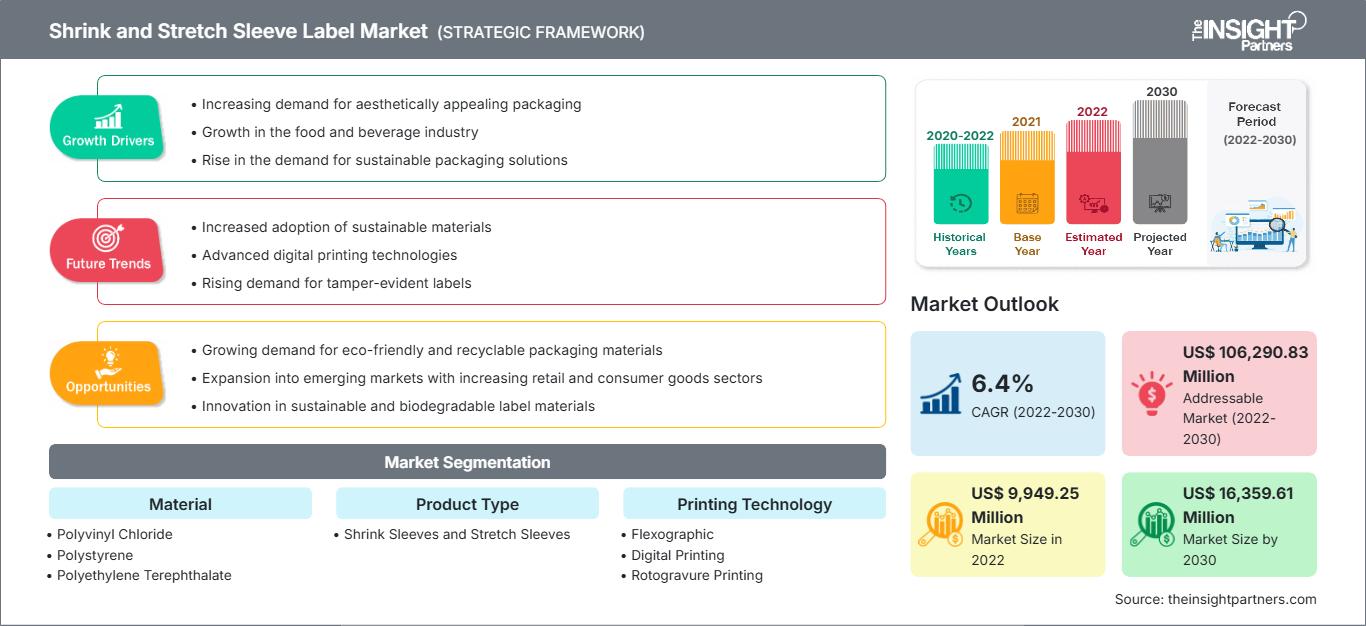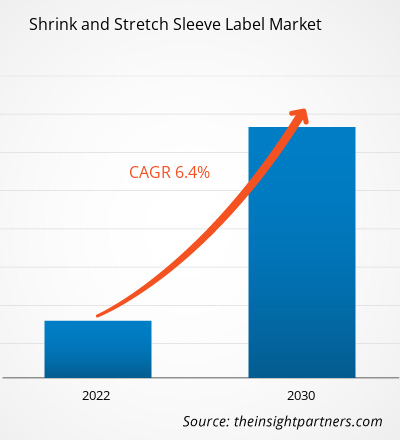[Forschungsbericht] Der Markt für Schrumpf- und Stretch-Sleeve-Etiketten hatte im Jahr 2022 ein Volumen von 9.949,25 Millionen US-Dollar und soll bis 2030 16.359,61 Millionen US-Dollar erreichen; von 2022 bis 2030 wird eine durchschnittliche jährliche Wachstumsrate (CAGR) von 6,4 % erwartet.
MARKTANALYSE
Der Markt für Stretch- und Shrink-Sleeve-Etiketten spiegelt ein dynamisches Umfeld wider, das von sich wandelnden Verbraucherpräferenzen, technologischem Fortschritt und dem Fokus auf nachhaltige Verpackungslösungen geprägt ist. Mit dem anhaltenden Wachstum der Verpackungsindustrie hat die Nachfrage nach optisch ansprechenden und informativen Etiketten zu einer zunehmenden Verbreitung von Stretch- und Shrink-Sleeve-Etiketten geführt. Diese Etiketten bieten eine vielseitige Lösung zur Produktdifferenzierung mit lebendigen Grafiken und 360-Grad-Branding. Die Einhaltung gesetzlicher Vorschriften und die Betonung umweltfreundlicher Verpackungen tragen zur Attraktivität von Sleeve-Etiketten bei, da Hersteller nach nachhaltigen Alternativen suchen. Der Markt profitiert von Innovationen in der Drucktechnologie, die komplexe Designs und die Integration intelligenter Verpackungsfunktionen ermöglichen.
Technologische Fortschritte spielen eine entscheidende Rolle bei der Gestaltung der Landschaft. Kontinuierliche Innovationen in der Drucktechnologie ermöglichen komplexe Designs und die Integration intelligenter Verpackungsfunktionen. Die Zusammenarbeit innerhalb der Branche zwischen Verpackungsunternehmen, Etikettenherstellern und Endverbrauchern fördert ein Umfeld der Innovation und Effizienz. Die Vielseitigkeit von Stretch- und Schrumpffolienetiketten findet Anwendung in so unterschiedlichen Sektoren, darunter Lebensmittel und Getränke, Pharmazeutika und Körperpflege, und trägt zum nachhaltigen Wachstum des Marktes bei.
WACHSTUMSTREIBER UND HERAUSFORDERUNGEN
Schrumpf- und Stretchfolienetiketten bieten eine 360-Grad-Abdeckung für lebendige und optisch ansprechende Grafiken. Die Etiketten ermöglichen Marken, ihre Produkte durch kreative Verpackungsdesigns und Etikettenformen zu differenzieren. Diese Etiketten sind manipulationssicher und gewährleisten die Integrität der verpackten Produkte. Der Lebensmittel- und Die Getränkeindustrie ist hart umkämpft, und die Attraktivität im Regal spielt eine bedeutende Rolle bei der Nachfrage nach Lebensmitteln und Getränken. Tragbare Verpackungen und Einzelportionsverpackungen erfreuen sich in der Branche zunehmender Beliebtheit. Schrumpffolien sind außerdem so konzipiert, dass sie sich bei Hitzeeinwirkung während der Anwendung eng an die Konturen von Produktbehältern anpassen. Durch die Anpassungseigenschaften können sich die Etiketten an verschiedene Formen und Größen von Flaschen, Gläsern, Behältern und anderen Gegenständen anpassen. Die enge Passform sorgt für ein attraktives und nahtloses Erscheinungsbild der Verpackung. Schrumpffolien dienen zudem als wirksame Originalitätsverschlüsse und bieten so eine zusätzliche Sicherheitsebene für verpackte Produkte. Stretch- und Schrumpffolienetiketten werden jedoch aus Kunststoffen wie Polyvinylchlorid, Polyethylen und Polyethylenterephthalat hergestellt. Diese Materialien sind hinsichtlich der Recyclingfähigkeit problematisch, und ihr Vorhandensein im Abfallstrom kann zu Umweltproblemen beitragen. Die weit verbreitete Verwendung von Stretch- und Schrumpffolienetiketten erzeugt Kunststoffabfälle und birgt Umweltrisiken.
Passen Sie diesen Bericht Ihren Anforderungen an
Sie erhalten kostenlos Anpassungen an jedem Bericht, einschließlich Teilen dieses Berichts oder einer Analyse auf Länderebene, eines Excel-Datenpakets sowie tolle Angebote und Rabatte für Start-ups und Universitäten.
Markt für Schrumpf- und Stretch-Sleeve-Etiketten: Strategische Einblicke

- Holen Sie sich die wichtigsten Markttrends aus diesem Bericht.Dieses KOSTENLOSE Beispiel umfasst Datenanalysen, die von Markttrends bis hin zu Schätzungen und Prognosen reichen.
Sie erhalten kostenlos Anpassungen an jedem Bericht, einschließlich Teilen dieses Berichts oder einer Analyse auf Länderebene, eines Excel-Datenpakets sowie tolle Angebote und Rabatte für Start-ups und Universitäten.
Markt für Schrumpf- und Stretch-Sleeve-Etiketten: Strategische Einblicke

- Holen Sie sich die wichtigsten Markttrends aus diesem Bericht.Dieses KOSTENLOSE Beispiel umfasst Datenanalysen, die von Markttrends bis hin zu Schätzungen und Prognosen reichen.
SEGMENTIERUNG UND UMFANG DES BERICHTS
Die „Globale Marktanalyse und Prognose für Schrumpf- und Stretch-Sleeve-Etiketten bis 2030“ ist eine spezialisierte und detaillierte Studie, die sich stark auf globale Markttrends und Wachstumschancen konzentriert. Der Bericht soll einen Überblick über den globalen Markt mit detaillierter Marktsegmentierung auf der Grundlage von Material, Produkttyp, Drucktechnologie, Endverbrauchsbranche und Geografie geben. Er liefert wichtige Statistiken zur Verwendung von Schrumpf- und Stretch-Sleeve-Etiketten weltweit sowie deren Nachfrage in wichtigen Regionen und Ländern. Darüber hinaus bietet der Bericht eine qualitative Bewertung verschiedener Faktoren, die die Marktleistung für Schrumpf- und Stretch-Sleeve-Etiketten in wichtigen Regionen und Ländern beeinflussen. Er enthält auch eine umfassende Analyse der führenden Akteure auf dem Markt für Schrumpf- und Stretch-Sleeve-Etiketten und ihrer wichtigsten strategischen Entwicklungen. Eine Analyse der Marktdynamik ist ebenfalls enthalten, um die wichtigsten Antriebsfaktoren, Markttrends und lukrativen Gelegenheiten zu identifizieren, die wiederum bei der Identifizierung der wichtigsten Einnahmequellen helfen.
Die Ökosystemanalyse und Porters Fünf-Kräfte-Analyse bieten eine 360-Grad-Ansicht des globalen Marktes für Schrumpf- und Stretch-Sleeve-Etiketten, die dabei hilft, die gesamte Lieferkette und die verschiedenen Faktoren zu verstehen, die das Marktwachstum beeinflussen.
SEGMENTANALYSE
Der globale Markt für Schrumpf- und Stretch-Sleeve-Etiketten ist nach Material, Produkttyp, Drucktechnologie und Endverbrauchsbranche segmentiert. Basierend auf dem Material ist der Markt in Polyvinylchlorid, Polystyrol, Polyethylenterephthalat, Polyethylen und andere unterteilt. Polyvinylchlorid ist ein vielseitiger thermoplastischer Polymer, der für seine Transparenz, Flexibilität und Kosteneffizienz bekannt ist. Es wird oft wegen seiner Fähigkeit bevorzugt, sich effizient an die Form der Verpackung anzupassen, wenn während des Schrumpfprozesses Hitze angewendet wird. Es bietet eine beträchtliche Schrumpfrate. Bei Stretch-Sleeve-Etiketten wird Polyvinylchlorid aufgrund seiner Flexibilität und Haltbarkeit verwendet. Je nach Produkttyp ist der Markt in Schrumpf- und Stretch-Sleeves unterteilt. Schrumpf-Sleeves bestehen aus flexiblem Kunststoffmaterial, das sich bei Hitzeeinwirkung eng an die Konturen der Verpackung anpasst. Schrumpf-Sleeves werden aus Materialien wie Polyvinylchlorid, Polyethylenterephthalat oder anderen Kunststofffolien hergestellt. Je nach Drucktechnologie ist der Markt in Flexodruck, Digitaldruck, Tiefdruck und andere segmentiert. Die Flexodrucktechnologie ist für ihre hohe Druckqualität und Kosteneffizienz bekannt. Daher ist diese Technologie eine bevorzugte Wahl für die Herstellung von Schrumpf- und Stretch-Sleeve-Etiketten. Es handelt sich um ein wiederholbares Verfahren, das sich für die Etikettenproduktion in großen Mengen eignet und sich an verschiedene Folientypen und -stärken anpasst, die üblicherweise in der Sleeve-Produktion verwendet werden. Basierend auf der Endverbraucherbranche ist der Markt in Lebensmittel und Getränke, Pharmazeutika, Chemikalien, Konsumgüter, Körperpflege und Kosmetik, Automobil und Transport und andere segmentiert. Stretch- und Schrumpf-Sleeve-Etiketten spielen in der Lebensmittel- und Getränkeindustrie eine entscheidende Rolle. Getränkeindustrie und dienen sowohl funktionalen als auch Marketingzwecken. Stretch- und Schrumpfsleeve-Etiketten werden häufig in Lebensmitteln und Getränken wie Säften, Energydrinks und alkoholischen Getränken verwendet. Die Schutzversiegelung dieser Etiketten verhindert, dass Lebensmittel und Getränke absichtlich oder unabsichtlich geöffnet werden.
REGIONALE ANALYSE
Der Bericht bietet einen detaillierten Überblick über den globalen Markt für Schrumpf- und Stretchsleeve-Etiketten in Bezug auf fünf Hauptregionen: Nordamerika, Europa, Asien-Pazifik (APAC), Naher Osten und Afrika (MEA) sowie Süd- und Mittelamerika (SAM). Der Asien-Pazifik-Raum hatte den größten Anteil am globalen Markt für Schrumpf- und Stretchsleeve-Etiketten und wurde im Jahr 2022 auf über 4 Milliarden US-Dollar geschätzt. Der Asien-Pazifik-Raum ist geprägt von der Präsenz von Lebensmittel- und Getränkeherstellern und ein Zentrum für mittelständische Unternehmen, die in der Region tätig sind. Europa wird bis 2030 voraussichtlich einen Umsatz von über 4,5 Milliarden US-Dollar erzielen. Nordamerika wird von 2022 bis 2030 voraussichtlich eine durchschnittliche jährliche Wachstumsrate (CAGR) von ca. 5 % verzeichnen. Der bequeme Lebensstil der Kunden spielt eine entscheidende Rolle für das Wachstum des Marktes für Stretch- und Schrumpffolienetiketten. Da die Menschen immer geschäftiger werden, steigt der Bedarf an verpackten Lebensmitteln.
BRANCHENENTWICKLUNGEN UND ZUKÜNFTIGE CHANCEN
Nachfolgend sind verschiedene Initiativen der wichtigsten Akteure auf dem Markt für Schrumpf- und Stretchfolienetiketten aufgeführt:
Im April 2023 gab Berry die Erweiterung seiner führenden Folienproduktionsanlage in Lewisburg, Tennessee, bekannt.
Markt für Schrumpf- und Stretch-Sleeve-Etiketten
Die Analysten von The Insight Partners haben die regionalen Trends und Faktoren, die den Markt für Schrumpf- und Stretch-Sleeve-Etiketten im Prognosezeitraum beeinflussen, ausführlich erläutert. In diesem Abschnitt werden auch die Marktsegmente und die geografische Lage in Nordamerika, Europa, dem asiatisch-pazifischen Raum, dem Nahen Osten und Afrika sowie Süd- und Mittelamerika erörtert.Umfang des Marktberichts für Schrumpf- und Stretch-Sleeve-Etiketten
| Berichtsattribut | Einzelheiten |
|---|---|
| Marktgröße in 2022 | US$ 9,949.25 Million |
| Marktgröße nach 2030 | US$ 16,359.61 Million |
| Globale CAGR (2022 - 2030) | 6.4% |
| Historische Daten | 2020-2022 |
| Prognosezeitraum | 2022-2030 |
| Abgedeckte Segmente |
By Material
|
| Abgedeckte Regionen und Länder | Nordamerika
|
| Marktführer und wichtige Unternehmensprofile |
|
Dichte der Marktteilnehmer für Schrumpf- und Stretch-Sleeve-Etiketten: Verständnis ihrer Auswirkungen auf die Geschäftsdynamik
Der Markt für Schrumpf- und Stretch-Sleeve-Etiketten wächst rasant. Dies wird durch die steigende Endverbrauchernachfrage aufgrund veränderter Verbraucherpräferenzen, technologischer Fortschritte und eines stärkeren Bewusstseins für die Produktvorteile vorangetrieben. Mit der steigenden Nachfrage erweitern Unternehmen ihr Angebot, entwickeln Innovationen, um den Bedürfnissen der Verbraucher gerecht zu werden, und nutzen neue Trends, was das Marktwachstum weiter ankurbelt.

- Holen Sie sich die Markt für Schrumpf- und Stretch-Sleeve-Etiketten Übersicht der wichtigsten Akteure
AUSWIRKUNGEN DER COVID-19-PANDEMIE/AUSWIRKUNGEN DES GEOPOLITISCHEN SZENARIOS/AUSWIRKUNGEN EINER REZESSION
Vor der COVID-19-Pandemie verzeichneten viele Länder weltweit ein Wirtschaftswachstum. Wichtige Hersteller investierten in die Forschung und Entwicklung von Schrumpf- und Stretch-Sleeve-Etiketten. Sie konzentrierten sich außerdem auf die Ausweitung ihrer geografischen Reichweite durch Fusionen und Übernahmen, um eine breite Kundenbasis zu bedienen. Vor der Pandemie verzeichnete der Markt für Schrumpf- und Stretch-Sleeve-Etiketten aufgrund der steigenden Nachfrage aus der Chemie- und Werkstoffindustrie ein stetiges Wachstum. Während der Pandemie führten Unterbrechungen der Lieferkette, Rohstoff- und Arbeitskräftemangel sowie betriebliche Schwierigkeiten zu einer Lücke zwischen Angebot und Nachfrage, die das Wachstum der Chemie- und Werkstoffindustrie negativ beeinflusste. Hersteller berichteten von Schwierigkeiten bei der Beschaffung von Rohstoffen und Zutaten von Lieferanten, was sich auf die Produktionsrate von Schrumpf- und Stretch-Sleeve-Etiketten auswirkte.
Mehrere Regionen meldeten eine Lücke zwischen Angebot und Nachfrage aufgrund der schwankenden Nachfrage aus der Chemie- und Werkstoffindustrie. Im Jahr 2021 trugen steigende Impfraten zu einer Verbesserung der Rahmenbedingungen in verschiedenen Ländern bei, was zu einem förderlichen Umfeld für die Chemie- und Werkstoffindustrie führte. Der Absatz von Schrumpf- und Stretch-Sleeve-Etiketten stieg mit der Wiederaufnahme der Produktion und des Vertriebs von Unternehmen der Chemie- und Werkstoffindustrie. Die steigende Nachfrage nach hochwertigen Schrumpf- und Stretch-Sleeve-Etikettenlösungen in diesen Branchen hat das Wachstum des Marktes für Schrumpf- und Stretch-Sleeve-Etiketten vorangetrieben.
WETTBEWERBSLANDSCHAFT UND WICHTIGE UNTERNEHMEN
CCL Industries Inc., Huhtamaki Oyj, Berry Global Group Inc., Amcor Plc, Coveris Management GmbH, Stratus Packaging SAS, KP Holding GmbH & Co KG, Fuji Seal International Inc, Oerlemans Plastics BV und Maca Srl gehören zu den wichtigsten Akteuren auf dem Markt für Schrumpf- und Stretch-Sleeve-Etiketten.
- Historische Analyse (2 Jahre), Basisjahr, Prognose (7 Jahre) mit CAGR
- PEST- und SWOT-Analyse
- Marktgröße Wert/Volumen – Global, Regional, Land
- Branchen- und Wettbewerbslandschaft
- Excel-Datensatz
Aktuelle Berichte
Verwandte Berichte
Erfahrungsberichte
Grund zum Kauf
- Fundierte Entscheidungsfindung
- Marktdynamik verstehen
- Wettbewerbsanalyse
- Kundeneinblicke
- Marktprognosen
- Risikominimierung
- Strategische Planung
- Investitionsbegründung
- Identifizierung neuer Märkte
- Verbesserung von Marketingstrategien
- Steigerung der Betriebseffizienz
- Anpassung an regulatorische Trends




















 Kostenlose Probe anfordern für - Markt für Schrumpf- und Stretch-Sleeve-Etiketten
Kostenlose Probe anfordern für - Markt für Schrumpf- und Stretch-Sleeve-Etiketten